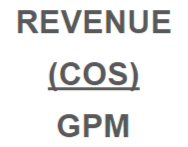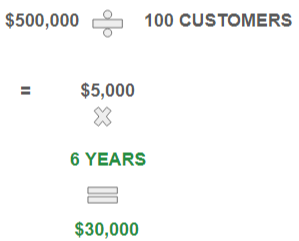Customer Lifetime Value (CLV)
One of our favorite financial metrics that we think all businesses should try to track is "Customer Lifetime Value". Some may refer to it as LTV or CLV. The Customer Lifetime Value metric will show how much each client or customer is going to be worth to a business over the whole period of the relationship.
-
1Video
-
2How to Calculate Customer Lifetime ValueTo calculate Customer Lifetime Value (CLV) look at the gross profit margin (GPM) on the profit and loss statement (P&L). GPM is calculated as Revenue less Cost of Goods Sold. Cost of Goods Sold may also be listed as Cost of Sales, depending how it is defined by the business. An inventory-based company may use "Cost of Good Sold" while a service- based company may call it "Cost of Sales." We recommend looking at gross profit over using net profit for various reasons, so this article refers to gross profit.
Gross Profit Margin - By using information from the P&L the GPM can be calculated:
Gross Profit Margin per Customer - Once the GPM is calculated, take the GPM and divide it by the number of unique customers the business has. If one customer buys from the business seven times, that customer will be counted as one customer.- Determine the GPM per customer by taking the gross profit divided by the number of unique customers
Gross Profit / # Unique Customers = GPM per Customer
Determine the average customer "lifetime" or how long they stay with the business (i.e., 5 years).
Customer Lifetime Value - Calculated by taking the gross profit per customer and multiplying it by the average customer lifetime.
Example:
An espresso company just started making an espresso coffee pod and they have a gross profit margin (GPM) of $500,000, and they have a total of 100 customers.
The gross profit per customer is $500,000 GPM / 100 customers = $5,000.
The espresso company has done research to determine that their average customer stays with them for 6 years.
The company can then calculate what their Customer Lifetime Value (CLV) is:
This little espresso pod company's CLV is $30,000. - Determine the GPM per customer by taking the gross profit divided by the number of unique customers
-
3Why is CLV Important?Knowing the CLV gives a business important financial information needed to run the business.
Marketing
The CLV can give the business an idea of how much to spend to acquire a new customer on things such as marketing and advertising. In the example above, the espresso pod company could set their marketing and advertising goals around the $30,000 CLV that was calculated.
There are some schools of thought out there in the marketing world that businesses can spend up to one year worth of client margin to buy that six year contract. A business will need to think about how much it is willing to spend to acquire a customer that will provide them with a certain amount of gross profit over the customer lifetime.Customer Experience Issues
CLV can also help identify business cycle issues. For instance, if a business thinks that the average period of stay is too short, the margin is too low, or the number of customers is too low, maybe there is something throughout the experience that is going wrong compared to others in the same industry.Customer Retention vs Customer Acquisition
Retention varies from industry to industry but retaining a customer can be 5 to 20 times less expensive than the cost of acquiring a new customer.
If the customer lifetime value can be increased by just 5 to 10%, a business is going to see big results as compared to having to spend more money to attract new customers.
How can a business boost the lifetime value of a client or customer? There may be changes to products and services that can be made or there may be other complimentary products and services that the business can sell.
Getting the CLV formula right is key to setting goals and improving the business as compared to others in the industry. Once the business understands its Customer Lifetime Value it can use it on a month-to-month, quarter-to-quarter basis to fully understand the business at this deeper level, and then focus on what can be changed over time to improve results.
Did this answer your question?
If you still have a question, we’re here to help. Contact us

